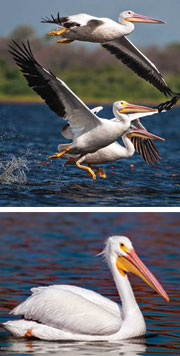

The white pelicans are clearly related to our native brown pelican, but their enormous size, stark-white plumage and tendency to travel in large flocks makes them a show-stopper for nearly everyone who sees them.
Weighing up to 30 pounds with wingspans extending up to nine feet, white pelicans are among the largest birds native to North America. They nest in colonies of 5,000 birds near brackish or freshwater lakes in isolated areas from Manitoba, Canada and Minnesota west to northern California. The American white pelican migrates to its winter grounds in the Fall – the original snowbirds.
Unlike brown pelicans, that capture prey by diving into the water, the white pelicans are more likely to “herd” fish. Working in groups of a dozen or more – and sometimes assisted by other species – the white pelicans corral fish into a small area where they are easier to eat. Once the fish are concentrated, the pelicans use their pouches as fishnets, submerging their heads and necks to scoop up the fish. They’ve even been known to steal food because they’re large enough to bully smaller birds.
White pelicans can be seen in many locations across Tampa Bay, from Fort DeSoto Park in Pinellas County to ponds in suburban Hillsborough. They’re voracious eaters – consuming about four pounds of fish daily – so they typically swoop into a pond, catch the easy prey and continue to a better spot. They historically roost at Tarpon Key near Fort DeSoto and can be seen there most evenings between October and February.
To learn more about the latest sightings of white pelicans, visitwww.pinellasbirds.com, join the Bird Brain listserve athttp://listserv.admin.usf.edu/listserv/wa.exe?A0=BRDBRAIN or follow Hillsborough County Birds on Facebook. Or read about some of the region’s best spots for all kinds of birds in the Winter 2009 issue of Bay Soundings.
[su_divider]
Originally published Winter 2013